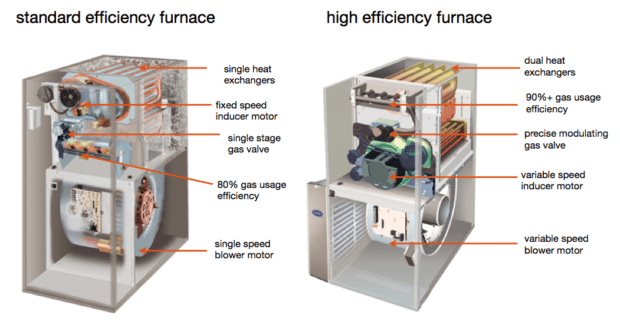Converting Your Furnace from Standard Efficiency to High Efficiency
What Homeowners Need to Know About Converting to a High-Efficiency Furnace
While admittedly a hot button environment issue, fracking has enabled domestic energy companies like Duke & IPL access to previously untapped energy resources. So what does this mean for me converting to a high-efficiency furnace? This translates into lower energy costs for you, the homeowner, on your oil and gas bills. Despite that, we also know it’s a depleting resource and can fluctuate quickly. While the government has significant oversight and regulatory control between utility companies and us as end-users, market forces dictate that if production costs of oil and natural gas increase, that cost will eventually be reflected in our bills. That’s not even touching on the impact of global demand and the complicated relationship we have with many of the significant energy-producing states around the world.
Amid all that uncertainty, many homeowners are determined to do whatever they can to reduce their energy dependency and environmental impact. With heating and cooling costs making up an average of 50% of overall utility bills, the move from standard efficiency to a high-efficiency furnace is one of the most meaningful upgrades a homeowner can make.
4 Things Every Homeowner Needs to Know When Converting
1. Flue conversion
Your 80% or less efficiency furnace vents through a metal pipe into a flue (many times inside of the same space as the chimney). This is because this pipe gets very hot. Your high-efficiency furnace will vent through 2/3/4 inch PVC pipe, and almost always include a 2nd flue pipe of the same size for intake air. This can involve a construction process because that PVC can rarely use the same space as your previous metal pipe. Many times this means drilling a hold in a side wall or roof.
2. Furnace Drainage
This new high-efficiency furnace is also called a condensing furnace. Condensing = condensation. That condensation will be expelled from the system into a 3/4 inch PVC line into wherever your current air conditioner drains. Many times this is a floor drain or a sump pit.
3. Reduction of Furnace Noise
It’s important to note your system should be much quieter than what you’re used to. Don’t be surprised. If you’re used to the house shaking when your blower motor kicks on, that’ll likely be gone too. Don’t worry that means your system is working better.
4. Comfort
With the high-efficiency blower, your system will likely have, your blasts of cold or hot air should be replaced with more consistent and less noticeable comfort. Those blasts of air in the past felt so lovely because your home was getting uncomfortable. Rather than going through cycles of comfort/discomfort, your new system is designed to create a more evenly distributed sense of comfort throughout your home.
There are other technical differences among these furnaces, and the above are critical experiential differences any homeowner should be aware of before they make the change to a high-efficiency furnace.
Have a question about how to save money on your energy bill, give us a call at 317-203-8149 or contact us. Homesense Heating & Cooling’s expert HVAC technicians will install the right furnace for your home in Indianapolis, Zionsville, Carmel, Fishers, or Geist.
